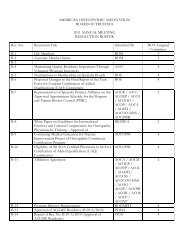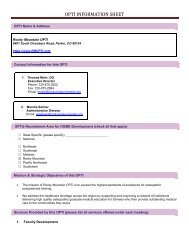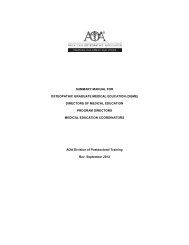Dialogue and Diagnosis - American Osteopathic Association
Dialogue and Diagnosis - American Osteopathic Association
Dialogue and Diagnosis - American Osteopathic Association
You also want an ePaper? Increase the reach of your titles
YUMPU automatically turns print PDFs into web optimized ePapers that Google loves.
insulin therapy include a sense of<br />
personal failure, low self-efficacy,<br />
injection phobia, hypoglycemia concerns,<br />
inadequate health literacy, <strong>and</strong><br />
limited insulin self-management<br />
training, as well as having health care<br />
providers who inadequately explain<br />
risks <strong>and</strong> benefits. 17<br />
Recent data show that patients<br />
who are non-adherent with clinic<br />
visits <strong>and</strong> insulin therapy are more<br />
likely to have higher HbA 1c levels <strong>and</strong><br />
face an increased risk for all-cause<br />
mortality compared to adherent compliant<br />
patients. 18 These data demonstrate<br />
the importance of ensuring<br />
that patients with diabetes mellitus<br />
are knowledgeable <strong>and</strong> comfortable<br />
with insulin therapy.<br />
To facilitate psychological<br />
receptiveness to injectable treatments<br />
among patients, physicians can<br />
encourage patients to self-monitor<br />
their blood glucose, they can educate<br />
patients about acceptable ranges for<br />
blood glucose readings, <strong>and</strong> they can<br />
discuss HbA 1c results with patients.<br />
Providing patients with injectable<br />
pen delivery devices <strong>and</strong> establishing<br />
a structured program of support<br />
during insulin initiation may also<br />
help patients overcome their<br />
anxieties about treatment. 19 Other<br />
factors to consider for facilitating<br />
insulin therapy include the<br />
following:<br />
Basal insulin analogs<br />
Long-acting insulin analogs (eg,<br />
insulin glargine <strong>and</strong> insulin detemir)<br />
are now firmly established as key<br />
tools in the battle against diabetes<br />
mellitus, <strong>and</strong> ongoing clinical<br />
research is focused on treatment<br />
strategies to maximize the benefits of<br />
these agents. Basal insulin analogs<br />
provide relatively uniform insulin<br />
coverage throughout the day <strong>and</strong><br />
night, primarily by controlling blood<br />
glucose levels through the<br />
suppression of hepatic glucose<br />
production between meals <strong>and</strong><br />
during sleep. 20 These agents are traditionally<br />
dosed once daily, at the same<br />
time each day. Recent data from the<br />
Outcome Reduction with Initial<br />
Glargine Intervention (ORIGIN) trial<br />
showed that insulin glargine had no<br />
positive or negative effect on cardiovascular<br />
outcomes <strong>and</strong> no association<br />
with cancer in patients with type 2<br />
diabetes. 21<br />
Although basal insulin analogs are<br />
associated with a lower risk of hypoglycemia<br />
than human neutral protamine<br />
Hagedorn (NPH) insulin,<br />
hypo glycemia is a dose-limiting<br />
adverse effect of these agents. 22<br />
Patients using basal insulin therapy<br />
are more likely to adhere to treatment<br />
if they are prescribed a long-acting<br />
basal analog (eg, detemir or glargine<br />
vs NPH) 23 <strong>and</strong> if they are able to<br />
administer insulin using a pre-filled<br />
pen (compared to the use of a vial<br />
<strong>and</strong> syringe). 24<br />
Continuation of oral medications<br />
along with basal insulin is a common<br />
clinical practice. The use of<br />
metformin mitigates insulinassociated<br />
weight gain <strong>and</strong> provides<br />
another mechanism of action by<br />
which to control hyperglycemia.<br />
Sulfonylureas may or may not be<br />
continued, depending on the patient<br />
<strong>and</strong> the physician’s clinical<br />
experience. Sulfonylureas are insulin<br />
secretagogues, <strong>and</strong> their use with<br />
insulin may increase the risk of<br />
hypogly cemia in some patients.<br />
Physicians are more likely to stop the<br />
use of sulfonylureas as the number of<br />
insulin doses increase; they should<br />
certainly consider discontinuing<br />
them regardless of the number of<br />
insulin doses if unacceptable<br />
hypoglycemia occurs, because the<br />
Address the patient’s beliefs about<br />
insulin.<br />
Assess the patient’s insulin<br />
experiences.<br />
Determine the best insulin regimen<br />
for the patient.<br />
Determine the best delivery device<br />
for the patient.<br />
Educate the patient about dose<br />
adjustment.<br />
Adjust the insulin regimen as<br />
necessary.<br />
<strong>Dialogue</strong> <strong>and</strong> <strong>Diagnosis</strong> // September 2012<br />
5

















